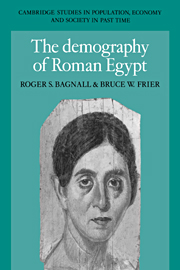Book contents
- Frontmatter
- Contents
- List of figures
- List of tables
- Foreword
- Preface
- A note on references and abbreviations
- 1 The census returns
- 2 The census returns as demographic evidence
- 3 Households
- 4 Female life expectancy
- 5 Male life expectancy and the sex ratio
- 6 Marriage
- 7 Fertility
- 8 Migration
- 9 Conclusion
- Catalogue of census declarations
- Catalogue of census declarations Supplement
- Appendixes
- 1 Minor corrections to census texts
- 2 Concordance of publications and household numbers
- 3 Statistical methods
- 4 Tables A–D
- Bibliography
- Index
- Cambridge Studies in Population, Economy and Society in Past Time
3 - Statistical methods
Published online by Cambridge University Press: 06 January 2010
- Frontmatter
- Contents
- List of figures
- List of tables
- Foreword
- Preface
- A note on references and abbreviations
- 1 The census returns
- 2 The census returns as demographic evidence
- 3 Households
- 4 Female life expectancy
- 5 Male life expectancy and the sex ratio
- 6 Marriage
- 7 Fertility
- 8 Migration
- 9 Conclusion
- Catalogue of census declarations
- Catalogue of census declarations Supplement
- Appendixes
- 1 Minor corrections to census texts
- 2 Concordance of publications and household numbers
- 3 Statistical methods
- 4 Tables A–D
- Bibliography
- Index
- Cambridge Studies in Population, Economy and Society in Past Time
Summary
At various points in this book, we use statistical methods to test theories about data derived from the census returns. The nature and purpose of these techniques are described in all standard introductions to statistics; we recommend R. E. Kirk, Statistics: An Introduction (3d ed.; 1990), to which we refer below. As a rule, these tests are easily performed either on a statistical calculator or with a computer statistics program.
Common to many statistical tests is a predetermined confidence level that indicates the degree of confidence one uses in accepting or rejecting a given hypothesis (Kirk, pp. 426–446). For data of the kind this book examines, the usual confidence level is 95 percent. If a test indicates significance at a higher than 95 percent confidence level, the statistical odds are less than one in 20 that the result is fortuitous.
Measures of dispersion
In Chapter 6, Section 2, we examine the gap in age between spouses for 78 cases attested in the census returns, where the gap is defined as the husband's age minus the wife's. The average (or arithmetic mean) of the attested gaps is simply their sum divided by the number in the sample (Kirk, pp. 84–87): in this instance, 7.53 years.
However, this average is not meaningful unless we also know the degree of typical dispersion about the mean, that is, the extent to which the attested figures normally vary from the average. The usual measurement of this dispersion is the standard deviation (Kirk, pp. 119–123), an easily determined statistic that measures dispersion by construing the attested figures as a normal bell curve;…
- Type
- Chapter
- Information
- The Demography of Roman Egypt , pp. 344 - 347Publisher: Cambridge University PressPrint publication year: 1994



